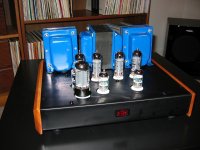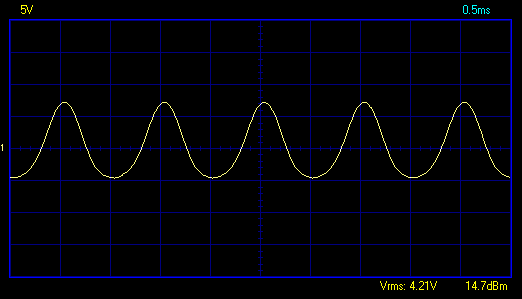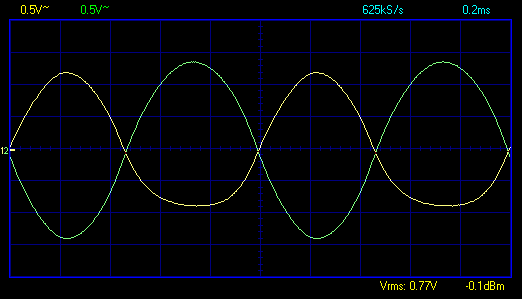Well, based on George's THD numbers, the effect would be subtle. I didn't have a reliable means to measure THD at the time I did all this. I just looked at and compared the spectra. It just feels wrong, though! 
Did you have GNFB hooked up, George? It definitely cleaned up the output for me at reasonable output levels. At full output it didn't make much difference.
Did you have GNFB hooked up, George? It definitely cleaned up the output for me at reasonable output levels. At full output it didn't make much difference.
I only asked the question because I have lot's of gear with various EH tubes installed.
Never a problem; they are the workhorses of the tube audio world. Sure, you can go broke buying NOS, and then find they don't sound better (if at all) than an EH.
Thanks to the Edcor waiting line, my SP-P will be a couple of months away from playing music, but I have a new quad of EH EL84 ready for that day.
Speaking of Edcor....
Before I put them on my new Millett DCPP, I just sat them on the unfinished Tubelab SP-P, to see if they fit (they are the same physical size).
Tight but they fit. My wife says the amp looks "cute"...
Never a problem; they are the workhorses of the tube audio world. Sure, you can go broke buying NOS, and then find they don't sound better (if at all) than an EH.
Thanks to the Edcor waiting line, my SP-P will be a couple of months away from playing music, but I have a new quad of EH EL84 ready for that day.
Speaking of Edcor....
Before I put them on my new Millett DCPP, I just sat them on the unfinished Tubelab SP-P, to see if they fit (they are the same physical size).
Tight but they fit. My wife says the amp looks "cute"...
Attachments
Last edited:
I only asked the question because I have lot's of gear with various EH tubes installed.
Never a problem; they are the workhorses of the tube audio world. Sure, you can go broke buying NOS, and then find they don't sound better (if at all) than an EH.
Well, I don't think there is anything really wrong with them per se. They are not working like NOS tubes do, though. Those all seem to work fine in this amp...at lest the ones I tried and the ones George uses. A strong JJ tube also works fine, but as they wear this is going to be the result.
The problem in this case stems from the fact that the input stage is DC coupled to the phase splitter. So the operating point of the input section sets the bias of the phase splitter. At least that my take on it.
I got all the "bad" tubes to work by replacing the 75k input plate load resistors (R106 and R206) with a 120k or 150k. 150k helped the most. It had an overall positive effect on the distortion spectra of the amp, but I don't know if it had a negative impact for tubes that worked well before.
I haven't seen anything like that Russ, thank goodness. I've used EH 12AY7 and EH EL34 in other amps and no issues, sounded good. Those tubes you got certainly look unhealthy, no doubt about that.
Update on the LED's, after about another 50 hours run time, the bias has ended up around 36mA with B+ of 320V and around 38mA with B+ of 330V, depending on mains voltage. The bias on each pair of output tubes has always been within 1mA. I took out the 1000uF cathode bypass electro's today and the jury says it's definitely better without.
Great amp, just love it.
Neon, nice build, thanks for the pic. Hope the new tranny's arrive soon.
Ian.
Update on the LED's, after about another 50 hours run time, the bias has ended up around 36mA with B+ of 320V and around 38mA with B+ of 330V, depending on mains voltage. The bias on each pair of output tubes has always been within 1mA. I took out the 1000uF cathode bypass electro's today and the jury says it's definitely better without.
Great amp, just love it.
Neon, nice build, thanks for the pic. Hope the new tranny's arrive soon.
Ian.
I haven't seen anything like that Russ, thank goodness. I've used EH 12AY7 and EH EL34 in other amps and no issues, sounded good. Those tubes you got certainly look unhealthy, no doubt about that.
There appears to be two versions of the EH 12AT7. I have the older, long plate version from TubeDepot.com. There is a new version, the 12AT7WC-EH, which has shorter plates supposedly to reduce microphonics. It looks more like a 6DJ8 like the JJ 12AT7 does.
I don't know if my EH tubes are typical of that type, but they will work fine in situations where its plate is not DC-coupled to the next stage. In cases where they are, they may still work fine if the operating points are forgiving enough.
I feel a little responsible for holding this project up. I hope too many folks aren't waiting for the parts list to be blessed. If you want to cover your bases, you can order 2 extra resistors for R4. That is a 150k, 2W resistor that can be used in place of R106 and R206 if this issue is encountered. It doesn't need to be 3W since it won't be passing as much current.
I hesitate a little because I think George likes to run the 12AT7 fairly hot. SY runs his colder in his RLD amp, though.
I hesitate a little because I think George likes to run the 12AT7 fairly hot. SY runs his colder in his RLD amp, though.
.....snip....
Neon, nice build, thanks for the pic. Hope the new tranny's arrive soon.
Ian.
Hey, Ian, thanks for that nice comment!
Yeah... as the rest of you get your SP-P boards playin' music, I'm waiting on Edcor (sigh). At least they do seem to produce a quality product at an unbeatable price. Those xfmrs in the SP-P picture are now making amazing sound in the Millett amp. If they do the same for the Tubelab P-P, I'll be surrounded in great music.
Neon, George made some comments on post 294, "So far the only change would be increasing the value of R3 from 10 K ohms to 30 K ohms. This raises the bias on the heater winding for better H-K voltages over all the possible voltages seen in this design." Not sure if you saw that or not so thought I'd mention it.
A correction for my post about the LED's in post #305, replace the word "bias" with "plate current". I have 1 ohm resistors on the plates to check the current.
I finally got a reply from Antek, they say the power tranny is safe to 100C.
Ian
A correction for my post about the LED's in post #305, replace the word "bias" with "plate current". I have 1 ohm resistors on the plates to check the current.
I finally got a reply from Antek, they say the power tranny is safe to 100C.
Ian
There is a limit to the amount of DC potential that there can be between the heater and the cathode. The phase splitter cathode is floating at a fairly high potential and the voltage splitter formed by R3 and R4 floats the heater winding up to keep from violating that limit. If you float it even higher you can control how much 60Hz is induced into the cathode from having AC on the heaters.
No, that is a DHT thing and is usually required because the heater IS the cathode. That means that one end of the cathode is at a different voltage potential than the other end at any given time when AC is used. The hum pot tries to "balance" the swing of the AC heater voltage on the DC cathode voltage such that it sort of cancels itself out inside the tube. Doesn't really work 100%, but it can help.
In this case the heater is not electrically connected to the cathode in a direct sense, but there is a capacitive effect at work.
In this case the heater is not electrically connected to the cathode in a direct sense, but there is a capacitive effect at work.
Last edited:
What do you think the actual sonic difference the resistor change will make?
Most likely, none at all. If your amp works, leave it alone. The change is just to get the H-K voltage more centered between the two sections on the 12AT7's. The voltages are within spec unless you really get carried away with the B+ voltage, in which case your EL84's are already glowing. On a normal amp at realistic voltages no differences should occur. The engineer in me just likes to optimize things as boundary conditions are found. We do it all the time at here work. If I ever find something that warrants a change on existing amps, I will say so.
I hesitate a little because I think George likes to run the 12AT7 fairly hot. SY runs his colder in his RLD amp, though.
I find (especially in the Simple SE) that most NOS 12AT7's will generate less distortion when fed more current. That is the case with the Simple P-P too. It is also the case with the Simple P-P that the current in the splitter is determined by the bias conditions and the tube characteristics in the input section of the 12AT7 since they are direct coupled. The resistor values on the parts list work great with all of the NOS 12AT7's that I tried. Russ found some distortion in the signal at the output tube grids when some new production tubes are used. This is more evident with worn tubes. It is possible to make the signals look better on the scope traces with these tubes by changing resistor values, but this doesn't seem to translate to a better sounding amp.
My FFT analyzer is not running at this time since the old computer died. I plan to experiment with this a bit more and at least come up with a set of resistor values to use with these tubes if it makes an audible or measurable difference in the overall amp. Unfortunately I must make a trip to West Virginia next week and I will be gone for about 10 days. No experiments until I get back. On the bright side I should be able to stop at the Dayton hamfest on the way back so I should get some new stuff to torture.
Thanks to George and Russ for the explanations. Could you also accomplish the same thing by "injecting" the B+ to a center-tapped filament winding?
Yup. You can float the heater winding with the center tap.
There isn't one posted on his site, but you can use this preliminary one here:
http://www.diyaudio.com/forums/tubelab/148694-tubelab-simple-p-p-5.html#post1912901
It has no circuit values, but you can substitute them from the parts list.
http://www.diyaudio.com/forums/tubelab/148694-tubelab-simple-p-p-5.html#post1912901
It has no circuit values, but you can substitute them from the parts list.
- Home
- More Vendors...
- Tubelab
- Tubelab Simple P-P



